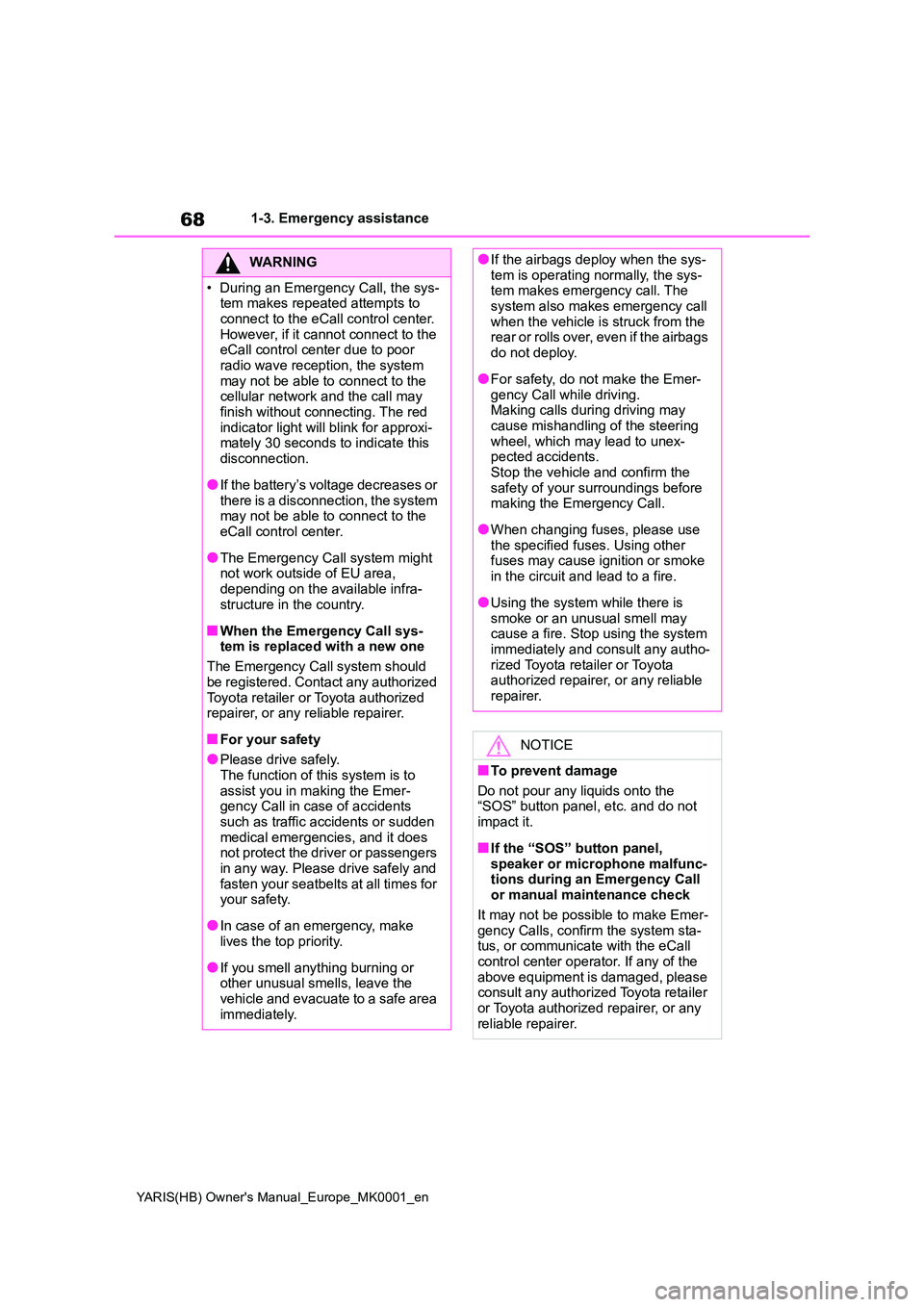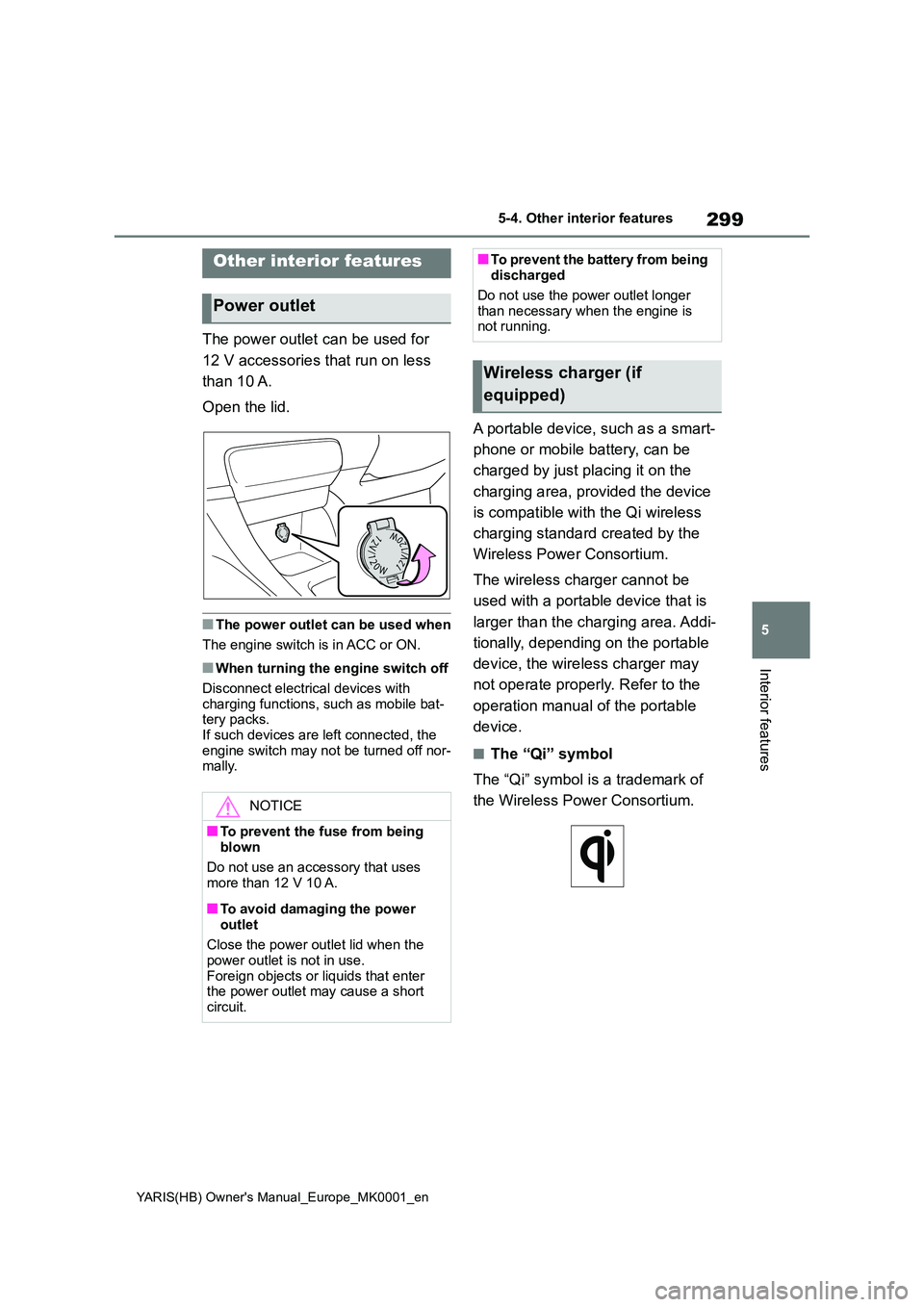2021 TOYOTA YARIS HATCHBACK fuse
[x] Cancel search: fusePage 4 of 568

4
YARIS(HB) Owner's Manual_Europe_MK0001_en
TABLE OF CONTENTS
5-1. Using the air conditioning
system and defogger
Manual air conditioning system
.......................................... 278
Automatic air conditioning sys-
tem .................................... 283
Heated steering wheel/seat
heaters.............................. 289
5-2. Using the interior lights
Interior lights list .................. 291
5-3. Using the storage features
List of storage features ....... 293
Luggage compartment features
.......................................... 295
5-4. Other interior features
Other interior features ......... 299
6-1. Maintenance and care
Cleaning and protecting the
vehicle exterior ................. 308
Cleaning and protecting the
vehicle interior .................. 311
6-2. Maintenance
Maintenance requirements . 314
6-3. Do-it-yourself maintenance
Do-it-yourself service precau-
tions .................................. 316
Hood ................................... 317
Positioning a floor jack ........ 319
Engine compartment........... 320
Tires .................................... 330
Tire inflation pressure ......... 340
Wheels ................................ 341
Air conditioning filter ........... 343
Wireless remote control/elec-
tronic key battery .............. 345
Checking and replacing fuses
.......................................... 348
Light bulbs .......................... 351
7-1. Essential information
Emergency flashers ............ 360
If your vehicle has to be stopped
in an emergency ............... 360
If the vehicle is trapped in rising
water ................................. 361
5Interior features
6Maintenance and care
7When trouble arises
Page 68 of 568

68
YARIS(HB) Owner's Manual_Europe_MK0001_en
1-3. Emergency assistance
WARNING
• During an Emergency Call, the sys- tem makes repeated attempts to
connect to the eCall control center. However, if it cannot connect to the eCall control center due to poor
radio wave reception, the system may not be able to connect to the cellular network and the call may
finish without connecting. The red indicator light will blink for approxi-mately 30 seconds to indicate this
disconnection.
●If the battery’s voltage decreases or
there is a disconnection, the system may not be able to connect to the eCall control center.
●The Emergency Call system might not work outside of EU area,
depending on the available infra- structure in the country.
■When the Emergency Call sys-tem is replaced with a new one
The Emergency Call system should
be registered. Contact any authorized Toyota retailer or Toyota authorized repairer, or any reliable repairer.
■For your safety
●Please drive safely.
The function of this system is to assist you in making the Emer-gency Call in case of accidents
such as traffic accidents or sudden medical emergencies, and it does not protect the driver or passengers
in any way. Please drive safely and fasten your seatbelts at all times for your safety.
●In case of an emergency, make lives the top priority.
●If you smell anything burning or other unusual smells, leave the
vehicle and evacuate to a safe area immediately.
●If the airbags deploy when the sys-tem is operating normally, the sys-tem makes emergency call. The
system also makes emergency call when the vehicle is struck from the rear or rolls over, even if the airbags
do not deploy.
●For safety, do not make the Emer-
gency Call while driving. Making calls during driving may cause mishandling of the steering
wheel, which may lead to unex- pected accidents.Stop the vehicle and confirm the
safety of your surroundings before making the Emergency Call.
●When changing fuses, please use the specified fuses. Using other fuses may cause ignition or smoke
in the circuit and lead to a fire.
●Using the system while there is
smoke or an unusual smell may cause a fire. Stop using the system immediately and consult any autho-
rized Toyota retailer or Toyota authorized repairer, or any reliable repairer.
NOTICE
■To prevent damage
Do not pour any liquids onto the “SOS” button panel, etc. and do not
impact it.
■If the “SOS” button panel,
speaker or microphone malfunc- tions during an Emergency Call or manual maintenance check
It may not be possible to make Emer- gency Calls, confirm the system sta-tus, or communicate with the eCall
control center operator. If any of the above equipment is damaged, please consult any authorized Toyota retailer
or Toyota authorized repairer, or any reliable repairer.
Page 299 of 568

299
5
YARIS(HB) Owner's Manual_Europe_MK0001_en
5-4. Other interior features
Interior features
5-4.Othe r in terior fe atu res
The power outlet can be used for
12 V accessories that run on less
than 10 A.
Open the lid.
■The power outlet can be used when
The engine switch is in ACC or ON.
■When turning the engine switch off
Disconnect electrical devices with
charging functions, such as mobile bat- tery packs.If such devices are left connected, the
engine switch may not be turned off nor- mally.
A portable device, such as a smart-
phone or mobile battery, can be
charged by just placing it on the
charging area, provided the device
is compatible with the Qi wireless
charging standard created by the
Wireless Power Consortium.
The wireless charger cannot be
used with a portable device that is
larger than the charging area. Addi-
tionally, depending on the portable
device, the wireless charger may
not operate properly. Refer to the
operation manual of the portable
device.
■The “Qi” symbol
The “Qi” symbol is a trademark of
the Wireless Power Consortium.
Other interior features
Power outlet
NOTICE
■To prevent the fuse from being blown
Do not use an accessory that uses
more than 12 V 10 A.
■To avoid damaging the power
outlet
Close the power outlet lid when the power outlet is not in use.
Foreign objects or liquids that enter the power outlet may cause a short circuit.
■To prevent the battery from being discharged
Do not use the power outlet longer
than necessary when the engine is not running.
Wireless charger (if
equipped)
Page 307 of 568

6
307
YARIS(HB) Owner's Manual_Europe_MK0001_en
6
Maintenance and care
Maintenance and care
6-1. Maintenance and care
Cleaning and protecting the
vehicle exterior ............... 308
Cleaning and protecting the
vehicle interior ................ 311
6-2. Maintenance
Maintenance requirements 314
6-3. Do-it-yourself maintenance
Do-it-yourself service precau-
tions ................................ 316
Hood ................................. 317
Positioning a floor jack...... 319
Engine compartment ........ 320
Tires .................................. 330
Tire inflation pressure ....... 340
Wheels.............................. 341
Air conditioning filter ......... 343
Wireless remote control/elec-
tronic key battery ............ 345
Checking and replacing fuses
....................................... 348
Light bulbs ........................ 351
Page 316 of 568

316
YARIS(HB) Owner's Manual_Europe_MK0001_en
6-3. Do-it-yourself maintenance
6-3.Do-it-y ours elf main ten ance
Do-it-yourself service
precautions
If you perform maintenance by
yourself, be sure to follow the
correct procedure as given in
these sections.
Maintenance
ItemsParts and tools
Battery con-
dition
( →P.325)
•Warm water
• Baking soda
• Grease
• Conventional wrench
(for terminal clamp
bolts)
Engine cool-
ant level
( →P.324)
• “Toyota Super Long
Life Coolant” or a simi-
lar high quality eth-
ylene glycol-based
non-silicate, non-
amine, non-nitrite and
non-borate coolant
with long-life hybrid
organic acid technol-
ogy.
“Toyota Super Long
Life Coolant” is pre-
mixed with 50% cool-
ant and 50% deionized
water.
• Funnel (used only for
adding coolant)
Engine oil
level
( →P.321)
• “Toyota Genuine Motor
Oil” or equivalent
• Rag or paper towel
• Funnel (used only for
adding engine oil)
Fuses
( →P.348)
• Fuse with same
amperage rating as
original
Light bulbs
( →P.351)
• Bulb with same num-
ber and wattage rating
as original
• Flathead screwdriver
•Wrench
Radiator,
condenser
( →P.324)
⎯
Tire inflation
pressure
( →P.340)
• Tire pressure gauge
• Compressed air
source
Washer fluid
( →P.329)
• Water or washer fluid
containing antifreeze
(for winter use)
• Funnel (used only for
adding water or
washer fluid)
WARNING
The engine compartment contains many mechanisms and fluids that
may move suddenly, become hot, or become electrically energized. To avoid death or serious injury, observe
the following precautions.
■When working on the engine
compartment
●Keep hands, clothing and tools away from the moving fan and
engine drive belt.
●Be careful not to touch the engine,
radiator, exhaust manifold, etc. right after driving as they may be hot. Oil and other fluids may also be hot.
●Do not leave anything that may burn easily, such as paper and
rags, in the engine compartment.
ItemsParts and tools
Page 321 of 568

321
6
YARIS(HB) Owner's Manual_Europe_MK0001_en
6-3. Do-it-yourself maintenance
Maintenance and care
Washer fluid tank (→P.329)
Fuse boxes (→P.348)
Engine oil filler cap (→P.322)
Engine oil level dipstick (→P.321)
Battery (→P.325)
Engine coolant reservoir (→P. 3 2 4 )
Radiator (→P.324)
Condenser (→P.324)
Electric cooling fan
With the engine at operating tem-
perature and turned off, check the
oil level on the dipstick.
■Checking the engine oil
1Park the vehicle on level
ground. After warming up the
engine and turning it off, wait
more than 5 minutes for the oil
to drain back into the bottom of
the engine.
2Holding a rag under the end,
pull the dipstick out.
1KR-FE engine
M15A-FKS engine
3Wipe the dipstick clean.
4Reinsert the dipstick fully.
Checking and adding the
engine oil
Page 348 of 568

348
YARIS(HB) Owner's Manual_Europe_MK0001_en
6-3. Do-it-yourself maintenance
1Turn the engine switch off.
2 Open the fuse box cover.
Engine compartment: type A
fuse box
Push the tabs in and lift the lid off.
Engine compartment: type B
fuse box
Push the tabs in and lift the lid off.
NOTICE
■When replacing the battery
Use a flathead screwdriver of appro-
priate size. Applying excessive force may deform or damage the cover.
■For normal operation after replacing the battery
Observe the following precautions to
prevent accidents:
●Always work with dry hands.
Moisture may cause the battery to rust.
●Do not touch or move any other component inside the remote con-trol.
●Do not bend either of the battery terminals.
■When removing the battery cover (vehicles without a smart entry &
start system)
Do not forcibly remove the battery cover, otherwise it may be damaged.
If the battery cover is difficult to remove, lift the edge to remove it.
Checking and replacing
fuses
If any of the electrical compo-
nents do not operate, a fuse
may have blown. If this hap-
pens, check and replace the
fuses as necessary.
Checking and replacing
fuses
Page 349 of 568

349
6
YARIS(HB) Owner's Manual_Europe_MK0001_en
6-3. Do-it-yourself maintenance
Maintenance and care
Under the driver’s side instru-
ment panel (left-hand drive vehi-
cles)
Remove the lid.
Make sure to push the claw when
removing/installing the lid.
Under the passenger’s side
instrument panel (right-hand
drive vehicles)
Remove the cover, connector (if
equipped) and then remove the lid.
Make sure to push the claw when
removing/installing the lid.
3 Remove the fuse with the pull-
out tool.
Only type A fuse can be
removed using the pullout tool.
4 Check if the fuse is blown.
Replace the blown fuse with a new fuse of an appropriate amperage rating. The
amperage rating can be found on the fuse box lid.
Typ e A
Normal fuse
Blown fuse